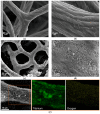Immobilization of Titanium(IV) Oxide onto 3D Spongin Scaffolds of Marine Sponge Origin According to Extreme Biomimetics Principles for Removal of C.I. Basic Blue 9
- PMID: 31105167
- PMCID: PMC6477614
- DOI: 10.3390/biomimetics2020004
Immobilization of Titanium(IV) Oxide onto 3D Spongin Scaffolds of Marine Sponge Origin According to Extreme Biomimetics Principles for Removal of C.I. Basic Blue 9
Abstract
The aim of extreme biomimetics is to design a bridge between extreme biomineralization and bioinspired materials chemistry, where the basic principle is to exploit chemically and thermally stable, renewable biopolymers for the development of the next generation of biologically inspired advanced and functional composite materials. This study reports for the first time the use of proteinaceous spongin-based scaffolds isolated from marine demosponge Hippospongia communis as a three-dimensional (3D) template for the hydrothermal deposition of crystalline titanium dioxide. Scanning electron microscopy (SEM) assisted with energy dispersive X-ray spectroscopy (EDS) mapping, low temperature nitrogen sorption, thermogravimetric (TG) analysis, X-ray diffraction spectroscopy (XRD), and attenuated total reflectance⁻Fourier transform infrared (ATR⁻FTIR) spectroscopy are used as characterization techniques. It was found that, after hydrothermal treatment crystalline titania in anatase form is obtained, which forms a coating around spongin microfibers through interaction with negatively charged functional groups of the structural protein as well as via hydrogen bonding. The material was tested as a potential heterogeneous photocatalyst for removal of C.I. Basic Blue 9 dye under UV irradiation. The obtained 3D composite material shows a high efficiency of dye removal through both adsorption and photocatalysis.
Keywords: extreme biomimetics; hydrothermal synthesis; marine sponges; photocatalysis; scaffolds; spongin; titanium dioxide.
Conflict of interest statement
The authors declare no conflicts of interest.
Figures








Similar articles
-
Creation of a 3D Goethite-Spongin Composite Using an Extreme Biomimetics Approach.Biomimetics (Basel). 2023 Nov 9;8(7):533. doi: 10.3390/biomimetics8070533. Biomimetics (Basel). 2023. PMID: 37999174 Free PMC article.
-
3D Spongin Scaffolds as Templates for Electro-Assisted Deposition of Selected Iron Oxides.Biomimetics (Basel). 2024 Jun 25;9(7):387. doi: 10.3390/biomimetics9070387. Biomimetics (Basel). 2024. PMID: 39056828 Free PMC article.
-
Spongin as a Unique 3D Template for the Development of Functional Iron-Based Composites Using Biomimetic Approach In Vitro.Mar Drugs. 2023 Aug 22;21(9):460. doi: 10.3390/md21090460. Mar Drugs. 2023. PMID: 37755073 Free PMC article.
-
Marine Spongin: Naturally Prefabricated 3D Scaffold-Based Biomaterial.Mar Drugs. 2018 Mar 9;16(3):88. doi: 10.3390/md16030088. Mar Drugs. 2018. PMID: 29522478 Free PMC article. Review.
-
Investigation of amino-grafted TiO2/reduced graphene oxide hybrids as a novel photocatalyst used for decomposition of selected organic dyes.J Environ Manage. 2018 Apr 15;212:395-404. doi: 10.1016/j.jenvman.2018.02.030. Epub 2018 Feb 22. J Environ Manage. 2018. PMID: 29455147 Review.
Cited by
-
Forced Biomineralization: A Review.Biomimetics (Basel). 2021 Jul 12;6(3):46. doi: 10.3390/biomimetics6030046. Biomimetics (Basel). 2021. PMID: 34287234 Free PMC article. Review.
-
Development of ZnO Nanoflake Type Structures Using Silk Fibres as Template for Water Pollutants Remediation.Polymers (Basel). 2020 May 18;12(5):1151. doi: 10.3390/polym12051151. Polymers (Basel). 2020. PMID: 32443444 Free PMC article.
-
Collagens of Poriferan Origin.Mar Drugs. 2018 Mar 3;16(3):79. doi: 10.3390/md16030079. Mar Drugs. 2018. PMID: 29510493 Free PMC article. Review.
-
Progress in Modern Marine Biomaterials Research.Mar Drugs. 2020 Nov 25;18(12):589. doi: 10.3390/md18120589. Mar Drugs. 2020. PMID: 33255647 Free PMC article. Review.
-
Electrochemical Sensing of Gallic Acid in Beverages Using a 3D Bio-Nanocomposite Based on Carbon Nanotubes/Spongin-Atacamite.Biosensors (Basel). 2023 Feb 13;13(2):262. doi: 10.3390/bios13020262. Biosensors (Basel). 2023. PMID: 36832028 Free PMC article.
References
LinkOut - more resources
Full Text Sources
Miscellaneous

